Each part of a house is unique with different requirements, and these should be reflected in its lighting design. A well lit room will completely change its feel, look and function.
To help you pick the best placement, fixtures and bulbs for getting the most out of a space, discover our guide to lighting ideas for every room of your home. We’ve broken down all of the technical terms that you should know and will show you how to work out exactly how much light your room needs. And we’ve also got expert advice from Aman Garcher on how to give your space a professional glow up.
The Language of Lighting
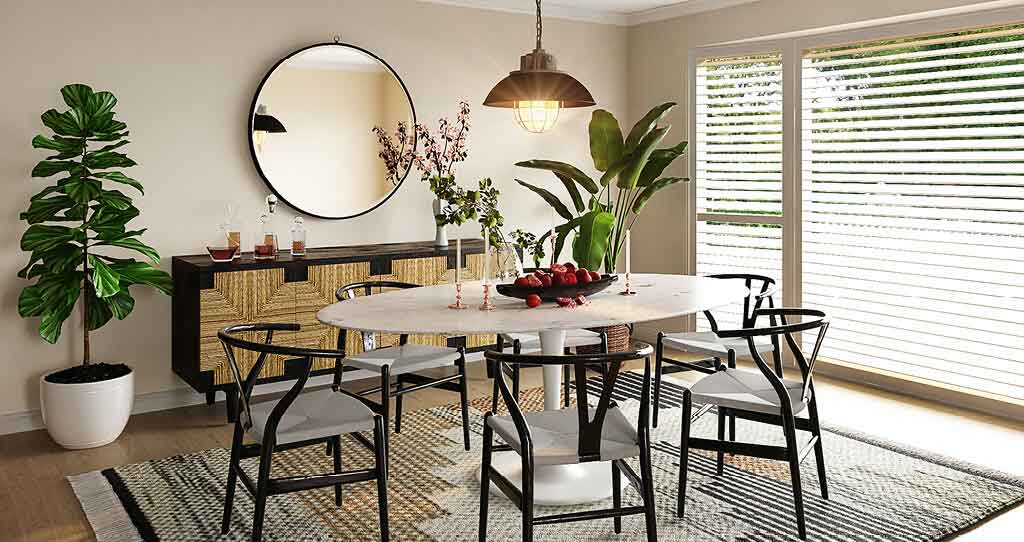

Lighting, like many aspects of home renovation, has its own vocabulary. Whether you’re tackling a big redesign job or are looking to add a bit of extra brightness to your space, it’s important to get to grips with what they all mean.
First, let’s look at the basics.
Ambient lighting
Ambient is the first and most basic layer of lighting. It refers to the general illumination of a room but also sets the tone. Due to these two main factors, it should offer a comfortable level of brightness that can be solely relied on without feeling overwhelming. Something that’s softer or can be adjusted to cater for day and nighttime. Ambient examples include ceiling-mounted fixtures that light the whole room and wall sconces and floor lamps that have a wide beam.
Task lighting
When you need something more direct and intense for a specific purpose, like reading, task lighting is the next layer to consider. It’s more focused than ambient, giving you more clarity to perform an action. The higher intensity also helps to prevent eye strain. Desk and table lamps, pendants, under-cabinet fixtures and bathroom mirror lights are a few task ideas that you can implement to improve visibility.
Accent lighting
The third and final layer is accent lighting. Accent lights are even more specialised than task lighting and are three times brighter than ambient. They’re intended to highlight an object or emphasise the aesthetic parts of a room, drawing attention to whatever they’re pointed at. Accent fittings are commonly used in commercial settings or professional environments where businesses may want to accentuate their products, but in the home, it’s less frequently used. If you have artwork, décor or architectural elements that you want to turn into a focal point, consider using track lighting, wall-mounted picture lights, upwards-shining beams or candlelight.
Uplighting
Uplighting is usually installed at a low or ground level to create a more open and ambient atmosphere. Uplights are less obstructed than downlighting (see below), so their glow can easily reach the ceiling and walls. They’re especially popular in garden lighting design to help guide pathways and driveways.
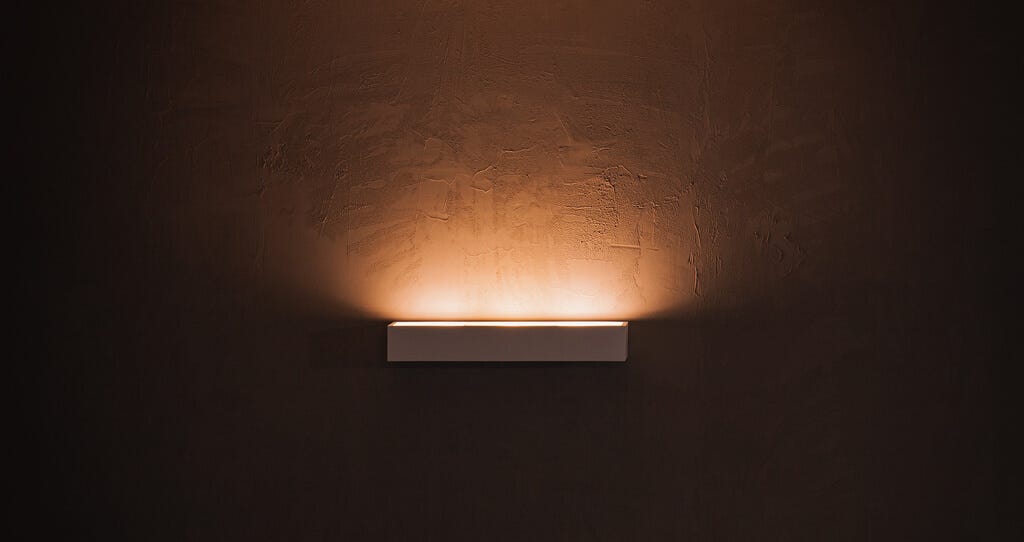

Downlighting
The opposite of uplighting, downlighting often sits at a higher position to point light towards the floor. Because of this, the beam can be obscured by furniture. This makes their effect more narrow and focused.
The technical terms that you’re not too sure about? We’ve broken them down too.
Kelvin
This is the scale for measuring the color temperature of light. The number of Kelvins that a bulb produces tells us how warm or cool it will shine. The lower it is on the Kelvin scale, the warmer and more yellow its light will be. If it has a higher number of Kelvins, the cooler and more blue it will be. It’s crucial to select a color temperature that fits the feel and objective of your room.
Lumens
Lumens are the other number that you’ll find on a light bulb box. It’s a measurement for how much light it produces. The more lumens, the brighter a source will be and more light it will generate. The lower the lumens, the dimmer it will be.
Wattage
Also known as watts, wattage refers to how much electricity a bulb consumes. In the past it was used as an indicator of brightness, but modern bulbs can produce more light while using less energy. Due to this, lumens are now the most accurate way to measure luminosity, and wattage should only really be used to work out electrical consumption.
Lux
You may have also come across the term lux. In countries where square meters are used, lux is the measurement used to figure out how many lumens a room needs. Here, one lux is equal to one lumen per square meter. Not to be confused with lumens, which tell us how much visible illumination is emitted from a source, lux is calculated by finding out how much light falls on a surface that’s one meter away from it. The amount of lux a source gives off to tell us how many lumens a room needs, based on its size, to be sufficiently lit.
Foot-candles
Foot-candles are the Imperial version of lux as a measurement of light intensity. One foot-candle signifies one lumen per square foot. If you’re looking to convert the two measurements of illuminance, one foot-candle is just over 10 lux.
Shopping for a new bulb? Here are the top types that you should know
Incandescent bulbs
These are traditional light bulbs that have been around for years. They consist of a wire filament that heats up to generate light. Despite being a household staple in the past, they can’t compare to newer, more efficient types. Less than 5% of the energy created from an incandescent bulb is used for illumination, the rest is lost as heat.
Compact fluorescent bulbs (CFL)
CFLs are one of the more energy efficient bulbs, using 60-80% less electricity than traditional incandescent types. Instead of a wire heated to form light, compact fluorescent bulbs use the electric current to heat the gases contained within. These gases are what cause the glass of a bulb to glow.
Halogen bulbs
Halogen bulbs use an inert gas and halogen mixture to produce light. They’re brighter than an incandescent bulb. These are somewhat energy efficient, using 20-30% less energy than incandescent bulbs.
Light-emitting diode bulbs (LED)
LEDs are one of the more common variants today. They use light emitting diodes which are extremely efficient, using up to 90% less energy than incandescent bulbs. Their more economical nature means that they can be more expensive upfront, but in the long run they will save you money and energy.
Lumens vs Kelvins
Choosing a bulb isn’t as simple as comparing lumens vs kelvins. It’s important to know what the scales mean and how they can affect the ambience of a room. Let’s take a closer look at them both.
Lumens
Lumens, also written as lm, tell us how much visible luminosity a source will give off. The higher the amount of lumens, the brighter it will appear. You’ll want a bulb with more lumens in rooms that you need extra clarity, like in kitchens and bathrooms.
The amount of lumens that household bulbs produce will typically range from 220 - 1,300. In comparison, the headlights of a car have around 3,000 lumens and flood-lights on a sporting pitch can have up to 20,000 lumens.
Incandescent, halogen, CFLs and LEDs will all have a lumen figure, but you’ll find that LEDs can create more at a lower wattage. That’s why it’s important to take these two factors into consideration when shopping, as looking for bulbs with higher numbers isn’t necessarily the best option.
To help you out, take a look at our cheat sheet below. It’ll tell you the approximate wattage requirements for different bulbs with a range of lumen outputs. Look for the more efficient bulbs by choosing one with a lower wattage but with enough lumens for what you need it for.
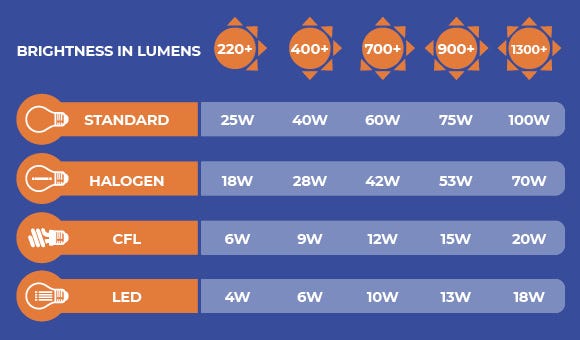

Kelvin
Kelvin, represented with K, refers to the color temperature of a bulb. Color temperature has nothing to do with actual temperature, but how yellow or white it shines.
The Kelvin temperature for household lights range from 2,000 - 6,000K. Bulbs with a lower temperature that falls between 2,000-3,000K will have an inviting, yellow glow. Natural candlelight also has a Kelvin temperature of around 2,000K or below. These warm lights offer a cozier ambience that’s similar to the color of traditional incandescent bulbs. They’re popular in living rooms and bedrooms as the lower temperature helps the brain to produce melatonin, a chemical which makes us feel relaxed and ready for sleep.
Moving up the scale are the bulbs between 3,100-5,000K. These produce a soft, white hue. They’re a lot more vibrant and are slightly cooler in color, with a little hint of blue light. Bulbs in this category are great for general indoor lighting as they mimic the effect of natural light, projecting a neutral look.
Bulbs with a higher Kelvin temperature between 5,100-6,500K are considered to be cool. They give off a crisp beam that leans almost blue-white, which is why they’re ideal for setting a fresh and modern look. Lights that hold a color temperature within this range emit more blue light waves, which have been found to encourage serotonin production. Serotonin helps us to feel more focused and awake, and so these bulbs are best placed in workspaces or wherever you need maximum illumination.
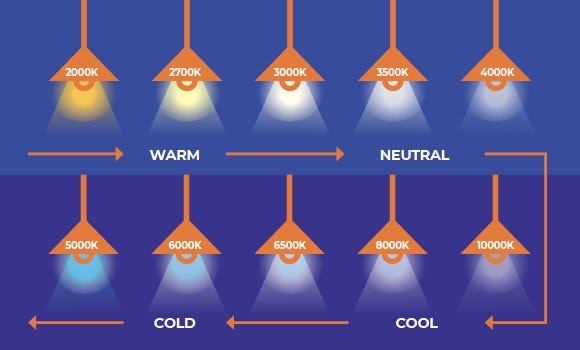

How Many Lumens Do I Need in My Room?
Now you know what kind of bulb is best for you, it’s time to work out how many of them you need in a room. Lumens tell us how bright a source is, so this calculation will help you figure out the total lumen count a room requires to be sufficiently lit. This figure can then be made up via various fixtures and lighting layers.
It’s a three step process:
Step 1: Determine your room’s square footage
Firstly, you’ll need to calculate how many square feet your room is. Do this by multiplying its length by its width. For example, if your living room is 10 feet wide and 10 feet long, its square footage will be 100 square feet.
Step 2: Workout the foot-candles of the room
Foot-candles are the intensity of a light source when one foot away. They tell us exactly how many lumens a room needs per square foot.
Each part of the home will have a different specification based on how much visibility we need in them. To find this out, take a look at our guide below. We’ve listed out how many foot-candles you’ll need per square foot for each room.
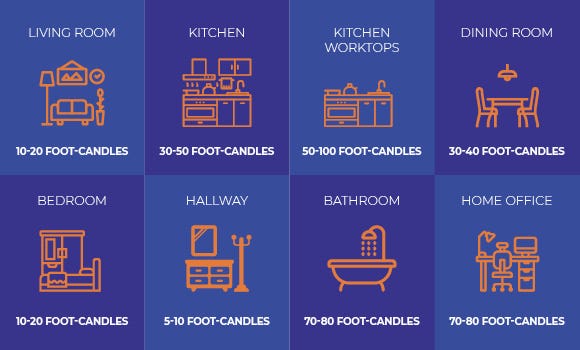

Our guide is based on the average 8-10 foot ceiling, but we understand that every home is different. If your ceiling is taller than 10 feet, we recommend adding 10-20 more foot-candles per foot in height onto the information above.
Step 3: Convert your foot-candles into lumens
The last step is to convert your foot-candles into the number of lumens you need. For this, you’ll need to take your room’s square footage and multiply it by your room’s foot-candle number. For example, for a 100 square foot living room that needs 10-20 foot-candles, you’ll want around 1,000-2,000 lumens split across various light sources.
When you’re looking at how to distribute your lumens through fixtures, there is a rule of thumb to follow. Each room should have a minimum of four individual points of light. This is so you can control each of them separately, allowing you to adapt the brightness to suit a variety of needs and create different moods.
Four is the minimum, but don’t be tempted to add too many, as this can overwhelm a room and take away from their effect.


Lighting Ideas for Every Room in Any Home
With all the technical parts out of the way and an idea of how many lumens you’ll need, you can now start to plan which types of fixtures that you want to use and what bulbs to pair with them. Keep reading as we take you through the most effective lighting ideas for each room in your home.
Aman Garcha of Styling Spaces main advice before you start is to “Layer your lighting!” She knows that every room needs a healthy mix of lights that blend really well together. “Otherwise your space will end up looking flat, which is the last thing you want in your home.”
“Lighting can make or break a space. If you do it wrong, your space will feel unloved. If you do it right, it adds a whole new dimension to your room. Not only illuminating all of your favorite spots, but adding depth to your space.” So with that in mind, let’s take a look at how we use these principles when lighting a room.


Living Room Lighting Ideas
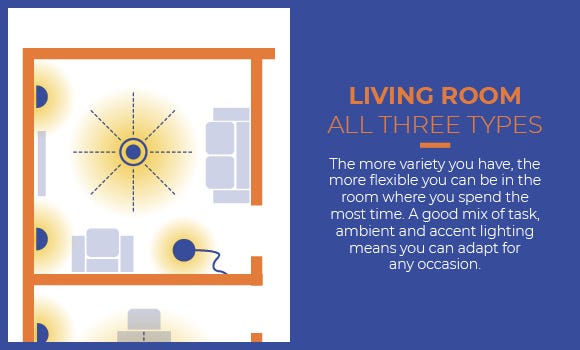

From date night entertaining to unwinding in the evening, having a mix of light sources in the living room means that you can adapt them to any occasion. The more variety you have, the more flexible you can be which is why we recommend implementing all three lighting layers - ambient, accent and task.
Ambient
Avoid placing ambient sources directly over areas with seating as this will cause an unflattering shadow, unless you use a fixture that angles the beam away. An alternative choice is to mount wall sconces so they can diffuse light upwards without being obstructed.
Task
Place a free standing or table lamp next to your sofa or armchair to use when reading. If you’re using spotlight lamps, position them away from the TV to reduce glare.
Hang a pendant over, but not directly over, your seating area to provide light when you need it. Pendants are also extremely beneficial for living rooms with high ceilings because they bring the light further down compared to other fixtures. Also, choose one with a narrow beam as they offer a more concentrated stream of light that’s more likely to reach the ground.
Accent
For artwork or architectural features that you want to accentuate, spotlights or picture lights are ideal for drawing attention to your living room’s focal points.
If you live in an apartment and have less space to work with, torchiere floor lamps are slender and take up less space than traditional table lamps. They’re excellent for illuminating the corner of rooms, particularly if your apartment gets little natural light. Ceiling and wall sconces also free up floor space, and they can be customised with minimalist shades to avoid a cluttered look.
Looking for smaller changes to make a big impact in your living room? Swap your regular bulbs for dimmable alternatives to help adjust the mood. You may need to replace your existing switch plate, but this is easy to do and inexpensive.
Also, look for bulbs with lower Kelvin temperatures that lean more yellow than blue. Avoiding blue light in the living room is important as it can make us alert and give us energy, which isn’t ideal for winding down in the night time.
Candles are considered a useful alternative to installing accent lighting as they shine upwards. They can be strategically placed around photo frames or other decorative pieces to highlight them. While candles are excellent for creating ambience, they do have a low lumen rating. This makes them better suited for accent or task rather than being a main source of illumination. Keep this in mind during your planning stage as they should be used in the final layer to add an atmospheric feel.
Kitchen Lighting Ideas
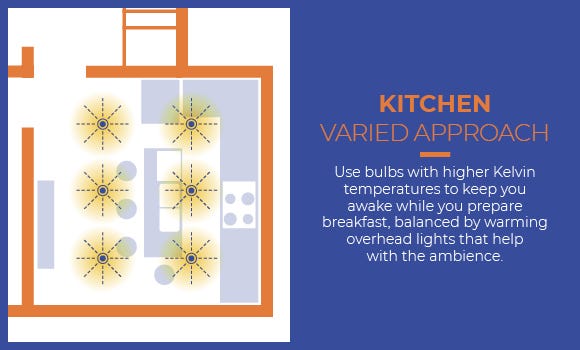

Kitchens also call for a varied but well-thought out approach as they serve lots of different purposes. They can also be trickier as some areas, like countertops, need a higher amount of lumens than others. Ambient and task should be the two layers to focus on.
Ambient
Ceiling fixtures like recessed or track lighting offer optimal ambient lighting that shines directly down on the room. These can also be angled to target any spots that are particularly dark. Keep these along the sides of the room rather than the centre to reduce shadows.
Task
Under-cabinet options are a popular task choice in the kitchen, as well as installing a row of hanging pendant lights above an island to brighten your workspace for everyday jobs.
To incorporate color temperature effectively, make use of bulbs with higher Kelvin temperatures as they emit more blue light. This will help to make you more awake as you prepare your breakfast in the morning. Many kitchens also have dining tables where overhead fixtures will benefit from bulbs with a warmer colour temperature. They’ll form a cosy ambience that balances out the blue light of other parts of the kitchen.
Plug in wall sconces are a convenient way of avoiding a rewiring job, which can transform the look of many apartments or rentals where a big renovation isn’t possible.
Dining Room Lighting Ideas
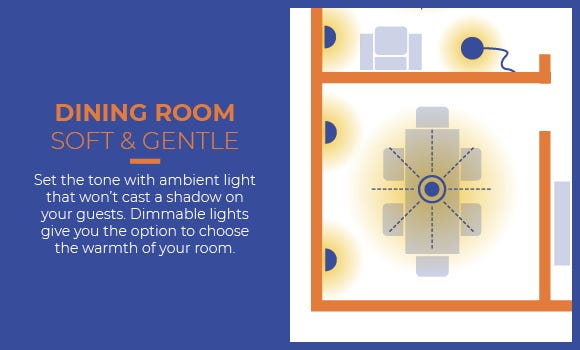

Dining rooms are more straightforward as they’re only really used for one purpose. They’re also usually one of the smaller rooms in the home, so they don’t require as many layers or lumens. Here’s how to get the best lighting for your next dinner party.
Ambient
Recessed, adjustable spotlights work well to highlight different visual elements or décor. They’ll set the tone for the room, just avoid placing them above your dining chairs so they don’t cast shadows on your guests.
Task
Chandeliers and pendants are a natural choice in dining rooms. Keep these directly over your table and be mindful of their size to avoid accidentally hitting your head on it when you stand up.
When it comes to bulbs, look for something neutral or that leans slightly warm. These will give a softer and gentler feel.
Accent
Accent lighting is rare in dining rooms, but candle centerpieces can be useful for emphasising pretty tablescapes. Bring these out for special occasions and tuck them away when not in use for homes short on space.
Whatever type of fitting you go for, be sure to pick the right bulb to complete the look. A dimmable option is best as you can adjust the light to create the perfect ambience to suit you.
Bedroom Lighting Ideas
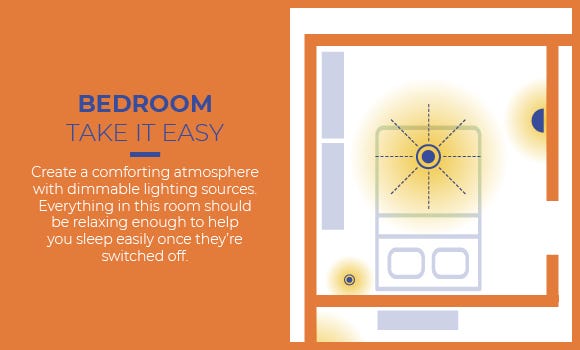

Of all your rooms, your bedroom should feel the most relaxed to help you get ready to sleep.
Ambient
Recessed lighting or a center pendant is sufficient for general bedroom tasks like making the bed, getting dressed and watching TV. An additional floor lamp helps to illuminate any dark corners, but to keep a calm atmosphere, avoid having too many ambient sources.
Task
Readers can benefit from a bedside lamp with a very low colour temperature bulb. White hues will alter our circadian rhythm and can also create a contrast against other white objects, like book pages.
Plug in sconces are convenient for smaller bedrooms that might have limited table or floor space, and they don’t require any rewiring or renovation work to install. Like dining rooms, having dimmable switch panels will help you to achieve a comforting atmosphere.
If your bedroom faces north or has small windows, you might get less sunlight. A tip for maximizing the brightness that you do get without having to add additional fittings is to use mirrors. Strategically placing them on the walls next to and opposite your windows is a great way to increase and bounce light around. It also means that in the evening you don’t have to worry about it being overly lit.
Children’s Room Lighting Ideas
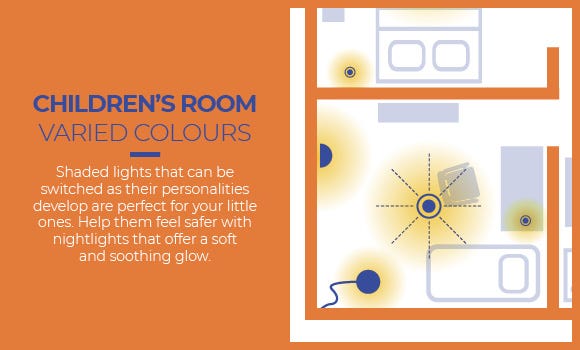

Children’s bedrooms should take a different approach. They’ll benefit from a colorful and varied environment to help stimulate them. Ambient and task are the layers to stick closely to, and having multiple sources that you can adjust means you can construct the perfect bedtime setting.
Ambient
A main ambient light, like a central pendant, is an investment that they can benefit from as they grow. This is because the shade can be changed to reflect their evolving personalities and own interior design taste. It should give them enough visibility to play, get dressed and do other daytime activities.
Task
Task is essential for reading, changing or any things which require more attention to detail. Reading lamps are a must and you can be more creative when selecting these. Why not shop novelty shapes or bring their favorite characters to life? Steer clear of free-standing or floor lamps, as they can be easily knocked over.
When choosing bulbs, soft-colored and warm shades add a fun touch without drastically changing the feel of the room. Colorful beams add a playful touch against cream or white walls. And don’t forget a plug in nightlight to add a soft, soothing glow.
Bathroom Lighting Ideas
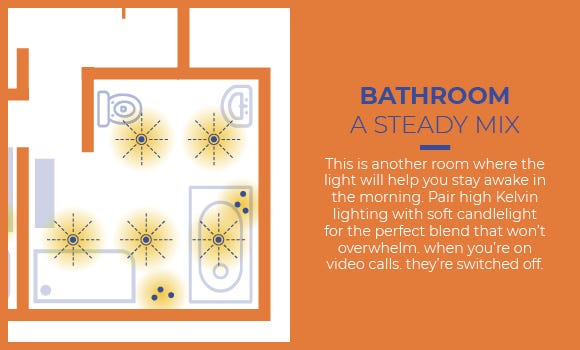

Bathrooms, like kitchens, call for excellent illumination as it’s where we get ready in the morning. You’ll want to carefully plan your approach as while they need the most lumens out of any room, you don’t want to overwhelm with too much light.
Ambient
Recessed ceiling lights that shine directly down can cast a lot of shadows. To stop this from happening, use adjustable ones where the beam can be angled, or install enough to offset any dimmer areas. Wall fixtures will also prevent this.
Task
There are two areas where task lighting is important in the bathroom - around the mirror and near the bathtub or shower. For fittings around the mirror, position them along the sides of the glass rather than above to reduce shadows as you get ready. These can be wired and designed into a bathroom, but battery operated lighting can be mounted for an easier, temporary solution. Candles also make relaxing task lighting around the bathtub.
In terms of bulbs, pick something with a higher Kelvin temperature for a natural or blue light. These will shine strongly to give powerful luminosity.
Home Office Lighting Ideas
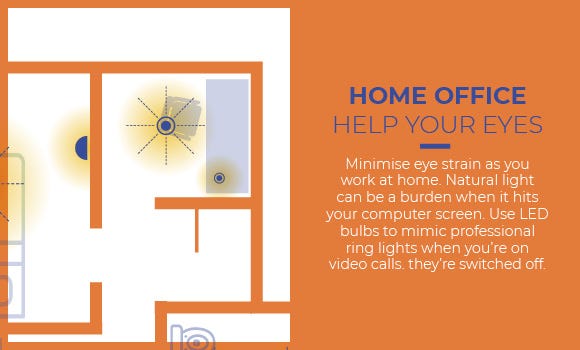

Home offices will need plenty of light, as this will help to minimise the risk of eye strain when you work. Natural light is prized in other areas around the house, but here, natural light can actually be a drawback. That’s because it can cause overexposure when you’re using your camera on meeting calls. To remedy this, fit blinds or light-filtering curtains.
Ambient
Overhead light fixtures like pendants will help to recreate a traditional office feel. Be careful though as they may cause glare on your monitor screen. Use a pendant or light shade to avoid this.
Task
Every home office desk needs a desk lamp. We strongly recommend an adjustable one so that you can position it away from your screen when you need to. Consider investing in LED bulbs for your lamps as they’re the brightest and offer optimal illumination for video calls. They mimic the effects of ring lights used in professional photography and videography, but are a more affordable alternative. Look for ones with cool-white Kelvin temperatures as they’re the most similar to daylight. This will help increase serotonin production to keep you focused and alert.
Accent
It’s common to see achievements or memorabilia on display in a home office, so you might even want to consider accent lighting to highlight these. Wall sconces are available in a range of designs, find one to match the style of your space.
Discover more lighting ideas inspired by the latest seasonal trends here or shop our collection of premium quality candles to light up your space today.




